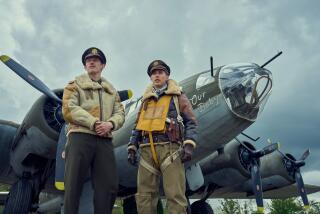Review: ‘Devotion’ gets into cockpit of 2 U.S. pilots who bond in Korean War
The framework of “Devotion: An Epic Story of Heroism, Friendship and Sacrifice” by military writer Adam Makos is the close relationship of two Navy pilots — Tom Hudner and Jesse Brown — during the Korean War.
Hudner was a New Englander, a son of privilege. He passed up Harvard to attend the Naval Academy, looking for adventure rather than a career in business like his father. Brown was an African American, the son of a sharecropper from Mississippi. He attended Ohio State in the late 1940s and saw a recruiting poster for naval aviation.
A poster like that would probably not have been seen at a black college, Makos reports: “There had been black pilots before: The Tuskegee Airmen had done the army proud during World War II. But the navy was a tougher nut to crack. Until Jesse, only whites had flow from carriers.”
Hudner emerged from the Korean War as a recipient of the Medal of Honor. Brown did not survive. The story of their friendship and Hudner’s desperate attempt to save Brown after he crashed deep behind enemy lines is an inspiring tale, particularly when portrayed by Makos in sharp, fact-filled prose and with strong reporting.
Makos is in the top ranks of military writers. His “A Higher Call,” with Larry Alexander, shows American and German pilots in close-in combat, and “Voices of the Pacific,” with Marcus Brotherton, follows Marines in the bloody campaigns of World War II.
If “Devotion” were simply the story of two dissimilar young Americans bonding during the brutality of war, it would merit attention. But Makos has done far more, and the result is a story that is wider, more compelling and more nuanced. “Devotion” shows the bonds among a youthful, largely inexperienced group of naval aviators, among Marine grunts, and, yes, even between those grunts on the frozen ground of North Korea and the flyboys providing cover.
Hudner and Brown flew Corsairs and Makos’ depiction of their bombing runs — dodging flak, searching for targets, worried about the condition of their aircraft — is riveting.
“Against a backdrop of gray clouds, the two blue Corsairs dived toward the snowy mountains,” Makos writes. “Tom glanced at Jesse as their planes plummeted side by side. Jesse’s helmeted head scanned back and forth, his eyes searching for a place to crash. He was going down, seventeen miles northwest of Hagaru, deep inside enemy territory.”
A helicopter pilot worries whether his chopper is up to the chore of rescuing downed pilots; “beneath the bravado, he had misgiving about the primitive machine he was tasked to fly.”
Above all, a Corsair pilot wanted desperately to win the respect of the best pilot in the squadron. After he made a harrowing landing on the carrier, he expected an attaboy. Instead, the other pilot said merely, “That’s about the worst landing I’ve ever seen” and walked away. Another pilot worries about possibly killing children during a bombing run. He can smell the burnt city below but is happy to see “the Korean children looking up, unharmed.”
Hudner is self-confident, a pipe smoker, a leader even as a junior officer. Brown is quiet, always aware of being a black man in a world that until recently was for whites only. A painful scene has Brown being refused a drink at a bar in San Diego and his fellow aviators leaving in angry protest.
But Makos cannot help building up the pilots as heroes among mere mortals. Too often he reaches for comparisons with movie stars. Scenes with the pilots and their wives or girlfriends are sepia-toned in a nostalgia for the days when men — real men — went to war and their women waited bravely at home: “An aviator has enough worries at work, he doesn’t need any more at home,” one says.
And there is a scene seemingly straight from an old movie (“Mister Roberts” comes to mind) of sailors gone wild on shore leave, drunkenly wearing “kepis, fezzes, fur shawls — and a few were carrying their incoherent buddies.”
But these are quibbles in a book with the length and emotional depth of “Devotion.” The ground combat scenes are vivid portrayals of the bitter cold and of Marines facing enemy troops in a mass onslaught: “A chorus of a thousand high-pitched Chinese voices arose: ‘Sha! Sha! Sha! Die, die, die. Cymbals began clanging and whistles began shrilling. The noise blended into a terrifying cacophony.”
Make no mistake, Americans die in “Devotion,” hundreds of them during the battle at Chosin Reservoir, in which they were badly outnumbered. Take the reaction of Pfc. John “Red” Patterson at seeing the reality of war: “Trucks passed with stiff bundles lashed to their bumpers. Red’s eyes narrowed. The bundles were blankets wrapped around something. Boots with snowy soles stuck from a bundle... Red’s jaw quivered. They’re dead Marines.”
The Korean War is often labeled, particularly by the men who fought in it, as the “forgotten war.” For readers of “Devotion” that description will no longer apply.
::
Devotion
An Epic Story of Heroism, Friendship and Sacrifice
Adam Makos
Random House: 445 pages, $28
More to Read
Sign up for our Book Club newsletter
Get the latest news, events and more from the Los Angeles Times Book Club, and help us get L.A. reading and talking.
You may occasionally receive promotional content from the Los Angeles Times.






